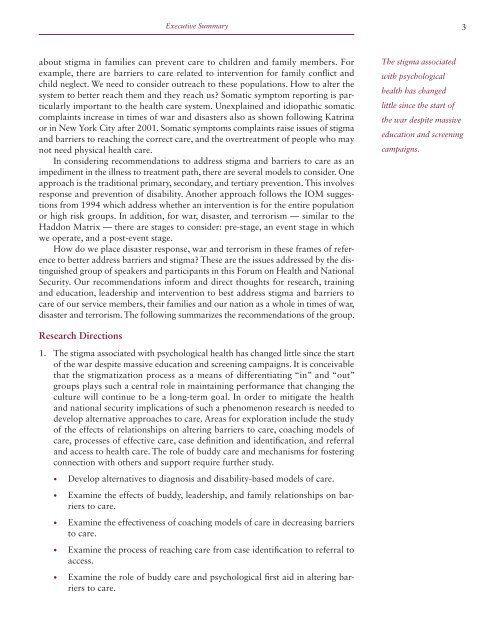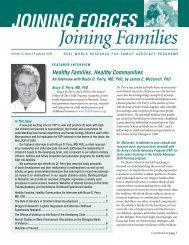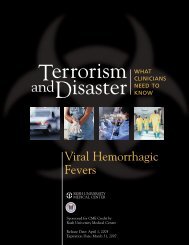stigma and barriers to care - Uniformed Services University of the ...
stigma and barriers to care - Uniformed Services University of the ...
stigma and barriers to care - Uniformed Services University of the ...
You also want an ePaper? Increase the reach of your titles
YUMPU automatically turns print PDFs into web optimized ePapers that Google loves.
Executive Summary 3<br />
about <strong>stigma</strong> in families can prevent <strong>care</strong> <strong>to</strong> children <strong>and</strong> family members. For<br />
example, <strong>the</strong>re are <strong>barriers</strong> <strong>to</strong> <strong>care</strong> related <strong>to</strong> intervention for family conflict <strong>and</strong><br />
child neglect. We need <strong>to</strong> consider outreach <strong>to</strong> <strong>the</strong>se populations. How <strong>to</strong> alter <strong>the</strong><br />
system <strong>to</strong> better reach <strong>the</strong>m <strong>and</strong> <strong>the</strong>y reach us Somatic symp<strong>to</strong>m reporting is particularly<br />
important <strong>to</strong> <strong>the</strong> health <strong>care</strong> system. Unexplained <strong>and</strong> idiopathic somatic<br />
complaints increase in times <strong>of</strong> war <strong>and</strong> disasters also as shown following Katrina<br />
or in New York City after 2001. Somatic symp<strong>to</strong>ms complaints raise issues <strong>of</strong> <strong>stigma</strong><br />
<strong>and</strong> <strong>barriers</strong> <strong>to</strong> reaching <strong>the</strong> correct <strong>care</strong>, <strong>and</strong> <strong>the</strong> overtreatment <strong>of</strong> people who may<br />
not need physical health <strong>care</strong>.<br />
In considering recommendations <strong>to</strong> address <strong>stigma</strong> <strong>and</strong> <strong>barriers</strong> <strong>to</strong> <strong>care</strong> as an<br />
impediment in <strong>the</strong> illness <strong>to</strong> treatment path, <strong>the</strong>re are several models <strong>to</strong> consider. One<br />
approach is <strong>the</strong> traditional primary, secondary, <strong>and</strong> tertiary prevention. This involves<br />
response <strong>and</strong> prevention <strong>of</strong> disability. Ano<strong>the</strong>r approach follows <strong>the</strong> IOM suggestions<br />
from 1994 which address whe<strong>the</strong>r an intervention is for <strong>the</strong> entire population<br />
or high risk groups. In addition, for war, disaster, <strong>and</strong> terrorism — similar <strong>to</strong> <strong>the</strong><br />
Haddon Matrix — <strong>the</strong>re are stages <strong>to</strong> consider: pre-stage, an event stage in which<br />
we operate, <strong>and</strong> a post-event stage.<br />
How do we place disaster response, war <strong>and</strong> terrorism in <strong>the</strong>se frames <strong>of</strong> reference<br />
<strong>to</strong> better address <strong>barriers</strong> <strong>and</strong> <strong>stigma</strong> These are <strong>the</strong> issues addressed by <strong>the</strong> distinguished<br />
group <strong>of</strong> speakers <strong>and</strong> participants in this Forum on Health <strong>and</strong> National<br />
Security. Our recommendations inform <strong>and</strong> direct thoughts for research, training<br />
<strong>and</strong> education, leadership <strong>and</strong> intervention <strong>to</strong> best address <strong>stigma</strong> <strong>and</strong> <strong>barriers</strong> <strong>to</strong><br />
<strong>care</strong> <strong>of</strong> our service members, <strong>the</strong>ir families <strong>and</strong> our nation as a whole in times <strong>of</strong> war,<br />
disaster <strong>and</strong> terrorism. The following summarizes <strong>the</strong> recommendations <strong>of</strong> <strong>the</strong> group.<br />
The <strong>stigma</strong> associated<br />
with psychological<br />
health has changed<br />
little since <strong>the</strong> start <strong>of</strong><br />
<strong>the</strong> war despite massive<br />
education <strong>and</strong> screening<br />
campaigns.<br />
Research Directions<br />
1. The <strong>stigma</strong> associated with psychological health has changed little since <strong>the</strong> start<br />
<strong>of</strong> <strong>the</strong> war despite massive education <strong>and</strong> screening campaigns. It is conceivable<br />
that <strong>the</strong> <strong>stigma</strong>tization process as a means <strong>of</strong> differentiating “in” <strong>and</strong> “out”<br />
groups plays such a central role in maintaining performance that changing <strong>the</strong><br />
culture will continue <strong>to</strong> be a long-term goal. In order <strong>to</strong> mitigate <strong>the</strong> health<br />
<strong>and</strong> national security implications <strong>of</strong> such a phenomenon research is needed <strong>to</strong><br />
develop alternative approaches <strong>to</strong> <strong>care</strong>. Areas for exploration include <strong>the</strong> study<br />
<strong>of</strong> <strong>the</strong> effects <strong>of</strong> relationships on altering <strong>barriers</strong> <strong>to</strong> <strong>care</strong>, coaching models <strong>of</strong><br />
<strong>care</strong>, processes <strong>of</strong> effective <strong>care</strong>, case definition <strong>and</strong> identification, <strong>and</strong> referral<br />
<strong>and</strong> access <strong>to</strong> health <strong>care</strong>. The role <strong>of</strong> buddy <strong>care</strong> <strong>and</strong> mechanisms for fostering<br />
connection with o<strong>the</strong>rs <strong>and</strong> support require fur<strong>the</strong>r study.<br />
••<br />
Develop alternatives <strong>to</strong> diagnosis <strong>and</strong> disability-based models <strong>of</strong> <strong>care</strong>.<br />
••<br />
Examine <strong>the</strong> effects <strong>of</strong> buddy, leadership, <strong>and</strong> family relationships on <strong>barriers</strong><br />
<strong>to</strong> <strong>care</strong>.<br />
••<br />
Examine <strong>the</strong> effectiveness <strong>of</strong> coaching models <strong>of</strong> <strong>care</strong> in decreasing <strong>barriers</strong><br />
<strong>to</strong> <strong>care</strong>.<br />
••<br />
Examine <strong>the</strong> process <strong>of</strong> reaching <strong>care</strong> from case identification <strong>to</strong> referral <strong>to</strong><br />
access.<br />
••<br />
Examine <strong>the</strong> role <strong>of</strong> buddy <strong>care</strong> <strong>and</strong> psychological first aid in altering <strong>barriers</strong><br />
<strong>to</strong> <strong>care</strong>.




